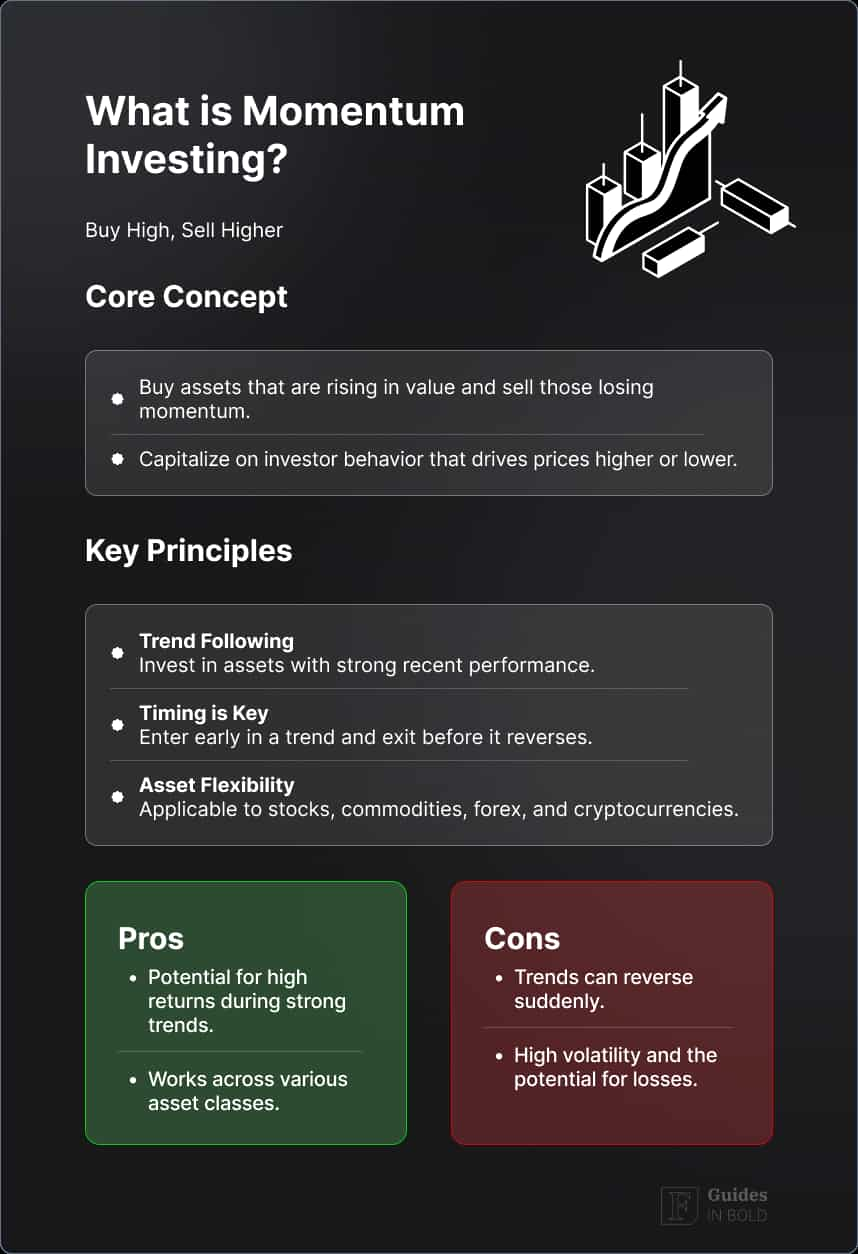Momentum investing defies the conventional wisdom of buying low and selling high. Instead, momentum investors aim at buying high and selling even higher. These traders are not discouraged by a rising share price but rather motivated by it. They pin their hopes that this upward trajectory will continue for some time and give them a chance to sell at an even higher price.
The following guide will examine momentum investing, how it works, the tools you need to apply for a successful strategy, and the pros and cons of this method.
Highly Rated Stock Trading & Investing Platform
-
Invest in stocks, ETFs, options and crypto
-
Copy top-performing crypto-traders in real time, automatically.
-
0% commission on buying stocks - buy in bulk or just a fraction from as little as $10. Other fees apply. For more information, visit etoro.com/trading/fees.
-
eToro USA is registered with FINRA for securities trading.
Momentum investing definition
The objective is to work with volatility by finding short-term upwardly trending buying opportunities and then selling when the securities lose momentum and repeating that process. The primary rationale behind momentum investing is that a well-established trend is likely to continue.

Read also:
What is Value Investing?
6 Basic Rules of Investing
Dividend Investing for Beginners
Stock Trading for Beginners
10 Best Stock Trading Books for Beginners
History of momentum investing
It’s unknown who invented momentum investing, but Richard Driehaus took the practice and constructed it into a strategy to run his funds. Instead of investing in undervalued stocks and waiting for the market to amend them, he believed in “buying high and selling higher.”

In 2004, he told Crain’s Chicago Business,
“I try to buy stocks that have already had good price moves, that are often making new highs and that have positive relative strength.”
Driehaus believed in selling the losers and letting the winners ride while reinvesting the capital from the past losers in stocks starting to boil. As a result, many of the techniques he used became the basics of what is now considered momentum investing.
Features of momentum investing
Momentum investing requires advanced risk management practices to address volatility, overcrowding, and hidden traps that reduce profits. The rules can be divided into five characteristics:
- Selection: the equities you choose;
- Risks revolve around the timing in opening and closing the trades;
- Entry timing means getting into the trade early;
- Position management pair wide spreads and your holding period;
- Exit points demand consistent charting.
Furthermore, momentum traders strive to analyze, understand, and, when possible, predict the behavior of other investors in the market. Therefore, awareness of behavioral biases and investor emotions can enormously improve the efficacy of a momentum investing strategy.
Technical analysis tools to detect momentum
The primary measure for momentum investors is technical analysis. Determining the strength or weakness of trends in stock prices requires knowledge of key technical indicators. Next, we’ll look at the four most commonly used technical indicators for a successful momentum trading strategy.
Trend lines
Trend lines are an essential technical analysis tool for tracking price movements to determine the current direction in market value. A trend line is drawn between two sequential points on a price chart to show the prevailing direction of the price. If the consequent line is sloping upward, it indicates a positive, bullish trend, and as such, an investor may buy shares. Conversely, if the resulting line is down-sloping, the trend is negative or bearish, and short-selling will be likely the most profitable position to adopt.
Moving averages
A moving average line enables traders to determine the prevalent trend without being distracted by the market “noise” from small, insignificant price fluctuations. An uptrend is usually indicated on a chart by price maintaining a position at or above a chosen moving average. Conversely, when a security’s price constantly remains at or below a moving average, a downtrend is usually reflected.
Stochastic oscillator
The stochastic oscillator compares an asset’s most recent closing price to a range of its prices over a certain period of time. When the closing price is near the high of the price range for the time period, the trend is positive. Conversely, when the closing price is near the low, this indicates a downward trend.
The value range for the stochastic oscillator is from 0 to 100. Higher numbers above 50 suggest a growing uptrend. In contrast, a momentous downtrend is indicated by lower numbers, below 50. However, an oscillator reading below 20 indicates oversold conditions in a market that may lead to a market reversal to the upside. Similarly, readings above 80 indicate overbought conditions and the potential for a bearish reversal.
The average directional index (ADX)
The Average Directional Index (ADX) is a favored momentum indicator and is typically less apt to produce false signals than the stochastic oscillator. Firstly, the ADX is used to determine the existence of a trend and, secondly, the trend’s strength. It does that by calculating the expansion (or contraction) of an asset’s price range over a defined time period.
The value range for ADX is from 0 to 100. Values below 25 (some traders use 20 rather than 25) indicate a ranging or directionless market with no clear trend. A reading above 25 shows a trend exists, and readings beyond that level indicate a stronger trend. That is to say, an ADX reading of 50 indicates a stronger trend than an ADX reading of 20.
Furthermore, investors look for the divergence between price movement and the ADX as a signifier of wilting momentum. For example, if the price makes a new high, but the ADX does not reach a further high reading, that is a bearish divergence of the ADX from price. In contrast, if the price falls to a new low but the ADX does not see a further low reading, that symbolizes a bullish divergence of the ADX from price.
Highly Rated Stock Trading & Investing Platform
-
Invest in stocks, ETFs, options and crypto
-
Copy top-performing crypto-traders in real time, automatically.
-
0% commission on buying stocks - buy in bulk or just a fraction from as little as $10. Other fees apply. For more information, visit etoro.com/trading/fees.
-
eToro USA is registered with FINRA for securities trading.
How momentum investing works
By employing a momentum investing strategy, investors look to profit from buying or selling short securities when they are strongly trending, i.e., have high price action momentum. A marker of high momentum is a wide range of price advances or declines in a short period of time. Typically markets that show high momentum also witness increased volatility.
Momentum investing is generally a short-term investing strategy, as the primary purpose of traders is to capture part of the price movement in a trend. Next, we’ll look at the steps of momentum investing trade.
Selecting you momentum security
Select liquid securities when employing momentum strategies. Avoid leveraged, or inverse ETFs due to complex fund construction since their price swings don’t accurately track underlying indices or futures markets. Regular funds make excellent trading instruments but tend to deliver smaller percentage gains and losses than individual securities.
Look for securities that trade more than 5 million shares per day if possible. Many popular stocks meet these standards, but even low float stocks can become highly liquid when news coverage and intense emotional reactions draw in-market investors from diverse sources.
Managing risk
The risks involved with momentum trading must be addressed and assessed in detail, or the strategy is likely to fail. Some of the drawbacks include:
- Getting into a position too abruptly before a momentum move is confirmed;
- Being late with closing the position after reaching saturation;
- Failing to keep up to date, missing changing trends, reversals, or news stories that take the market by surprise;
- Maintaining an open position overnight. You could wake up to radically different prices and patterns the following day since stocks are susceptible to external factors occurring after the close of that day’s trading;
- Failing to act fast to close an unfortunate position, riding the momentum in the opposite direction.
Timing your entry
The best momentum trades come after breaking news cycles, triggering rapid movement from one price level to another and, as a result, setting off buying or selling signals for observant traders who jump in and are rewarded with instant profits.
Further momentum capital enters as the trade develops, generating counter swings that shake out weak hands. The hot money population finally hits an extreme, triggering whipsaws (movement of shares in a volatile market when a stock price will unexpectedly switch direction) and major shifts in market momentum.
While early positions offer the most significant reward with the slightest risk, aging trends should be avoided no matter what. Unfortunately, the opposite happens in real-world scenarios since most traders won’t notice the opportunity until much later in the cycle and then fail to act prior to everyone else jumping in.
Managing position
Position management takes time to master because these securities often carry wide bid/ask spreads. Wide spreads require more significant movement in your favor to become profitable while also grinding through wide intraday (buying today and selling today) ranges that expose stops.
Risk increases the longer you stay positioned, so choosing your holding period wisely is critical. For example, day trading or crypto day trading work well with momentum strategies, but it forces players to take larger positions to compensate for multi-day holds’ more considerable profit potential. In contrast, it is best to reduce position size when holding multiple sessions to allow more substantial movement and stop placement further away from the current action.
Making a profitable exit
The right time to exit is when the price moves rapidly into an overextended technical state. A series of vertical bars often identify this overextended state on the 60-minute chart. Alternately, the price could pierce the third or fourth standard deviation of a top or bottom 20-day Bollinger Band (technical analysis tool).
Consider tightening up stops or a blind exit once technical barriers are hit, such as major trendline or previous high/low. When crossovers signal potential trend changes, exit or settle for partial profits.
Pros and cons of momentum investing
A risk-tolerant trader with the right personality will have a good chance at turning momentum investing strategies into lucrative profits. However, the same risk-return tradeoff that is present with other investing strategies also plays a part in momentum investing. As a result, a momentum investor is always at risk of timing a buy incorrectly and ending up losing it all.

Pros
- Momentum investing presents a potential for high profits over a short period. Let’s say an investor buys a stock that grows from $50 to $75 based upon an overly positive analyst report. They then sell at a profit of 50% before the stock price corrects itself, making a 50% return over a few weeks or months (not an annualized return);
- Allows the trader to capitalize on volatile market trends. Momentum investors look for stocks to invest in that are on their way up and then sell them before the prices begin to go back down. As a result, they must always stay ahead of the pack in terms of market trends;
- The entire concept of momentum investing is constructed around chasing performance. Momentum investors do this systematically, including a specific buy and sell point. As such, momentum investors can leverage the emotional decisions of other investors that ultimately cause changes in stock prices and take advantage of that.

Cons
- A significant concern for most rookie momentum traders is high stock turnover, which can be expensive in terms of fees;
- Momentum investing can be pretty time-consuming since traders have to track market details daily, if not hourly. Since they are handling stocks that will peak and go down again, they need to jump in early and get out fast, meaning staying up to that with the news to see if there is anything that will spook investors;
- Momentum investing performs best in a bull market since traders tend to herd a lot more. In contrast to a bear market, where the margin for profit on momentum investing shrinks under increased investor caution;
- There is a high likelihood of a trend reversal. The main component of momentum strategy is to assume the trend will continue in the same direction. Sometimes, however, the trend reverses, and this strategy fails.
In conclusion
To sum up, it’s crucial to understand that momentum trading does not come without its fair share of challenges. Essentially, you’re deciding to invest in a stock or ETF based on recent buying by other market participants. There’s no guarantee that buying pressures will continue to boost the price.
It is not for everyone but can often lead to exceptional returns if appropriately handled. However, it takes stringent discipline to trade in this style because all trades must be closed at the first sign of weakness, lest you experience significant loss.
Disclaimer: The content on this site should not be considered investment advice. Investing is speculative. When investing, your capital is at risk.
FAQs about momentum investing
What is momentum investing?
Momentum investing is a strategy that involves buying stocks or other securities that have been performing well over the past three to twelve months and selling those that have had poor returns over the same period. Momentum investing is essentially the opposite of buying low and selling high.
What are momentum stocks?
Momentum stocks are shares of companies whose stock prices have shown a trend of upward movement over a certain period. These stocks often continue to rise in price, driven by factors like strong earnings reports, positive industry news, or overall market trends.
What are some of the benefits of momentum trading?
Momentum trading can seem more attractive than buying low and selling high, because you are already buying an asset that is on an upward trend. You do not have to buy an undervalued asset and wait for the market to reassess that particular stock so that your investment finally turns profitable. Additionally, there is a strong potential for high profits over a short period.
What are some of the risks of momentum trading?
Like all trading strategies, momentum trading is not without risks. For example, you must time your entry and exit correctly and keep in mind the possibility of a trend reversal. In addition, the monitoring of market opportunities can be incredibly time-consuming and often includes high transaction costs.
What affects stock’s price momentum?
Various factors affect an asset’s momentum or short-term price change, such as the company’s fundamentals, news events, market volatility, and herding effect (the tendency of traders to follow the majority).
How to detect stock’s price momentum?
To detect momentum traders use technical indicators such as trend lines, moving averages, stochastic oscillator and the average directional indicator.
How to define a momentum investing strategy?
Momentum investing strategy involves buying stocks or other securities that have had high returns over the past three to twelve months, and selling those that have had poor returns over the same period. The core idea is that assets which are performing well will continue to perform well in the short to medium term, and those performing poorly will continue to perform poorly.
What's a momentum investing example?
A momentum investing example would be if an investor notices that a particular technology stock has been consistently outperforming the market over the past six months. They decide to invest in this stock, expecting that the trend will continue. The strategy focuses on riding the wave of existing market trends, rather than predicting new ones.
What is the difference between momentum investing vs value invetsing?
Momentum investing and value investing are two contrasting approaches. While momentum investing focuses on stocks that are currently performing well in the market, value investing involves buying stocks that are undervalued in the market. Value investors look for stocks that they believe the market has undervalued, with the expectation that their true value will be recognized eventually. Momentum investors, on the other hand, focus on the current trend of stock performance, betting on the continuation of that trend in the short term.
What is the best momentum ETF?
An example of a momentum ETF is the iShares MSCI USA Momentum Factor ETF. This Exchange Traded Fund specifically targets U.S. stocks that exhibit strong momentum characteristics. It follows the MSCI USA Momentum Index, selecting stocks that have shown an upward price trend. The fund adjusts its holdings regularly based on ongoing momentum scores, ensuring that it consistently aligns with the top-performing stocks in the current market. This strategy makes it an attractive option for investors looking to capitalize on the momentum investing approach without the need to actively manage their stock selections.
What is dual momentum investing?
Dual momentum investing is an investment strategy that combines relative momentum and absolute momentum. Relative momentum involves selecting securities that have performed better compared to others over a certain period. Absolute momentum, on the other hand, refers to investing in assets that have positive returns and moving to cash or bonds when those assets have negative returns. This strategy aims to capitalize on the continuation of existing market trends while reducing exposure during market downturns.
Where to buy momentum stocks?
To buy momentum stocks, investors typically turn to major stock exchanges and online brokerage platforms, such as eToro. These platforms provide access to a wide range of stocks, including those exhibiting strong momentum.
Highly Rated Stock Trading & Investing Platform
-
Invest in stocks, ETFs, options and crypto
-
Copy top-performing crypto-traders in real time, automatically.
-
0% commission on buying stocks - buy in bulk or just a fraction from as little as $10. Other fees apply. For more information, visit etoro.com/trading/fees.
-
eToro USA is registered with FINRA for securities trading.





